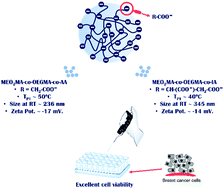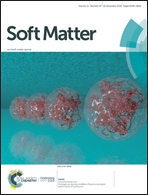Dual-responsive nanogels based on oligo(ethylene glycol) methacrylates and acidic co-monomers†
Abstract
Ethylene glycol-based nanogels (NGs) have demonstrated their potential for the development of next-generation formulations for biomedical applications due to their interesting properties. In this work, monodispersed NGs based on oligo(ethylene glycol) methacrylates (OEG) were synthesized through free radical precipitation/dispersion polymerization assisted by ultrasonication. Di(ethylene glycol)methyl ether methacrylate (DEGMA) and oligo(ethylene glycol) methacrylate (OEGMA; Mn 475 g mol−1) were used as the main monomers, acrylic acid (AA) or itaconic acid (IA) as co-monomers (OEG-co-AA and OEG-co-IA, respectively) and tetraethylene glycol dimethacrylate (TEGDMA) as crosslinker. The physicochemical properties of OEG-co-AA and OEG-co-IA NGs were studied including hydrodynamic diameter, poly-dispersity index, zeta potential and pH/temperature responsiveness. Samples with 4 mol% of both AA and IA showed nanometric sizes. Regarding their thermo-responsiveness, unexpected differences between NGs with AA or with IA were observed. Besides, NGs did not impair the cell viability of a breast tumour cell line even when high concentrations were added to the culture medium. The properties of the synthetized NGs showed that either NGs with 4% AA or with 4% IA are outstanding candidates for biomedical applications.



 Please wait while we load your content...
Please wait while we load your content...